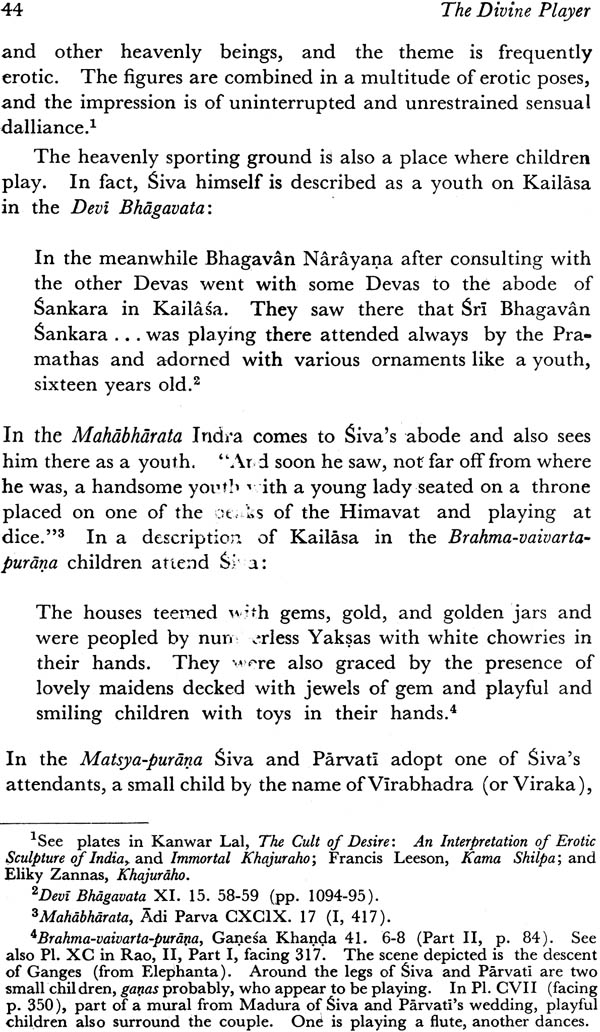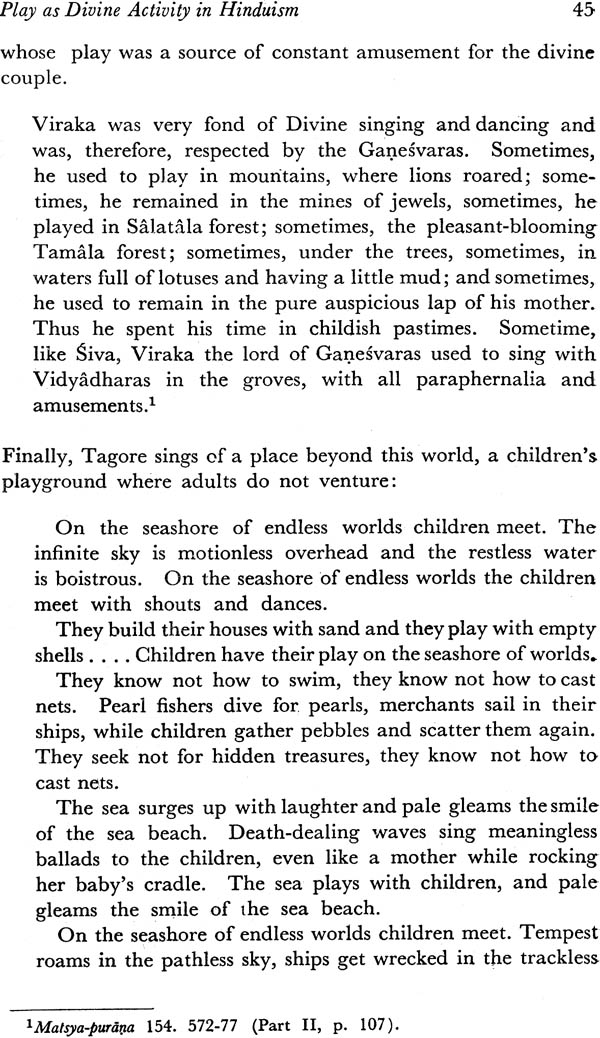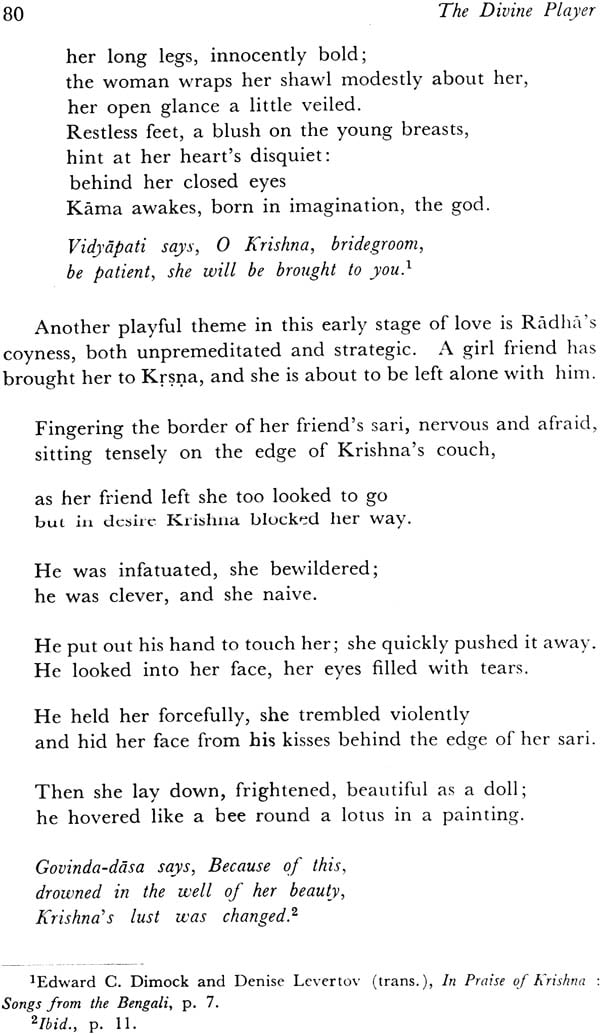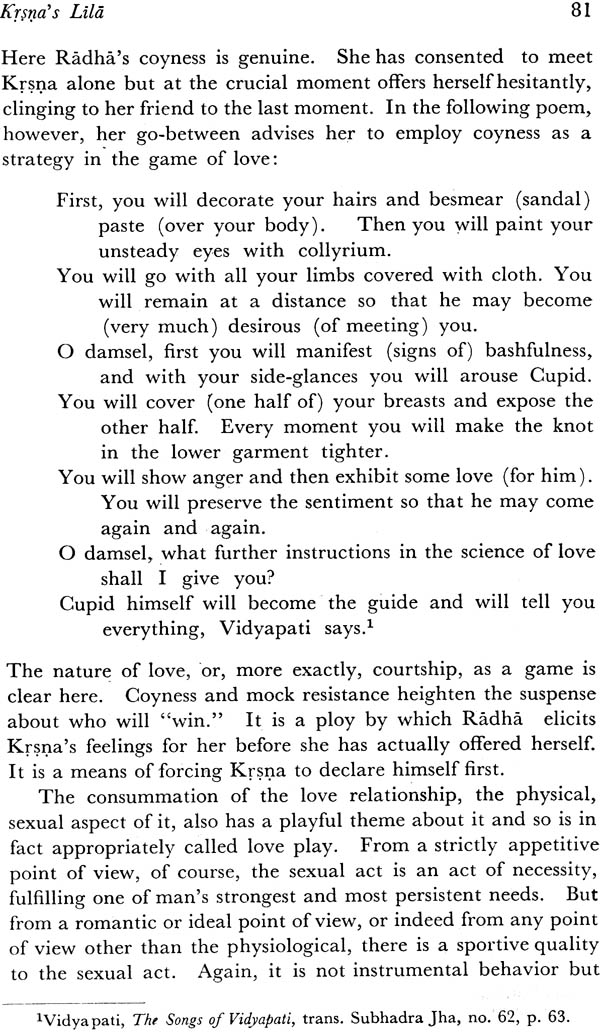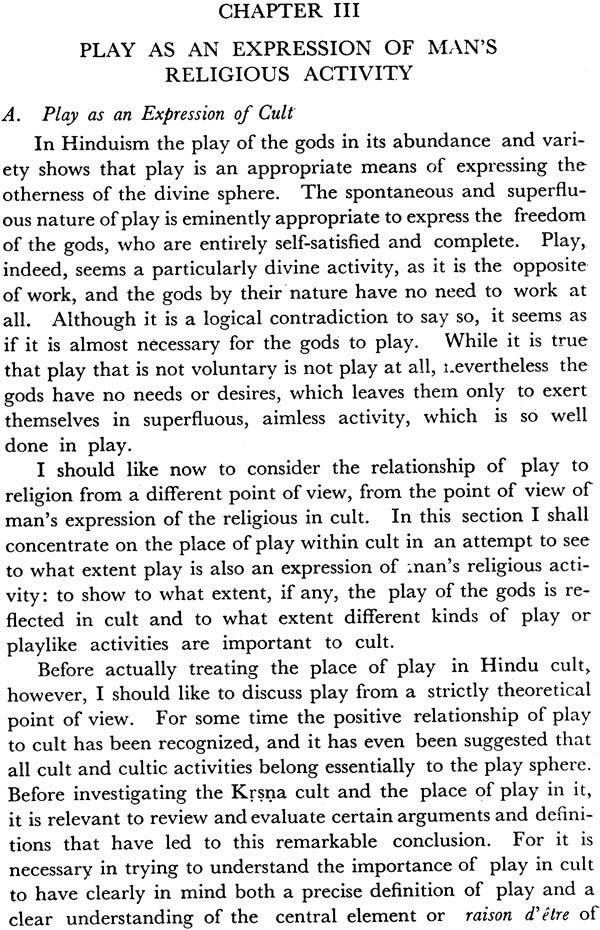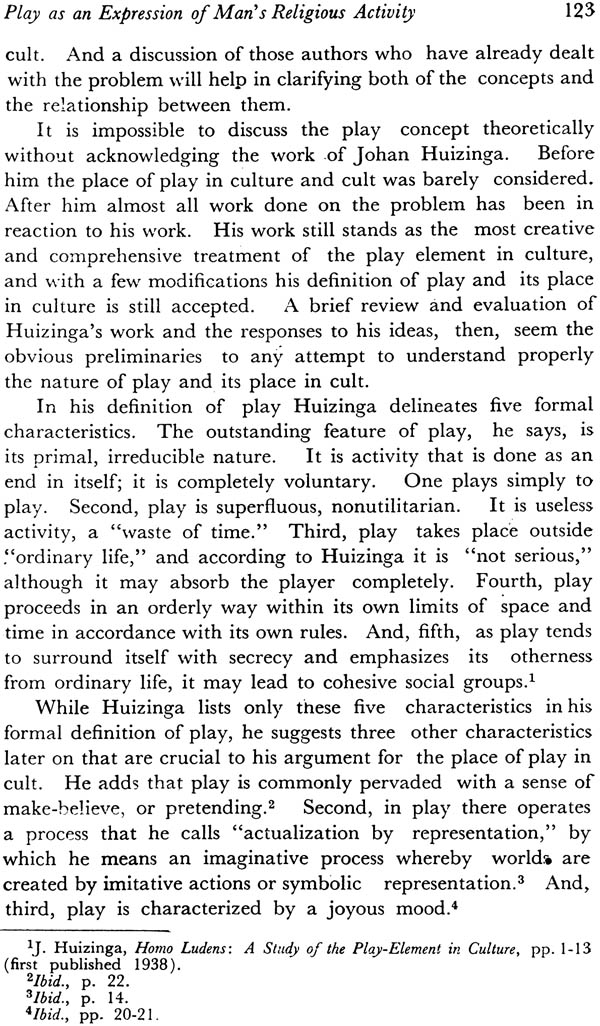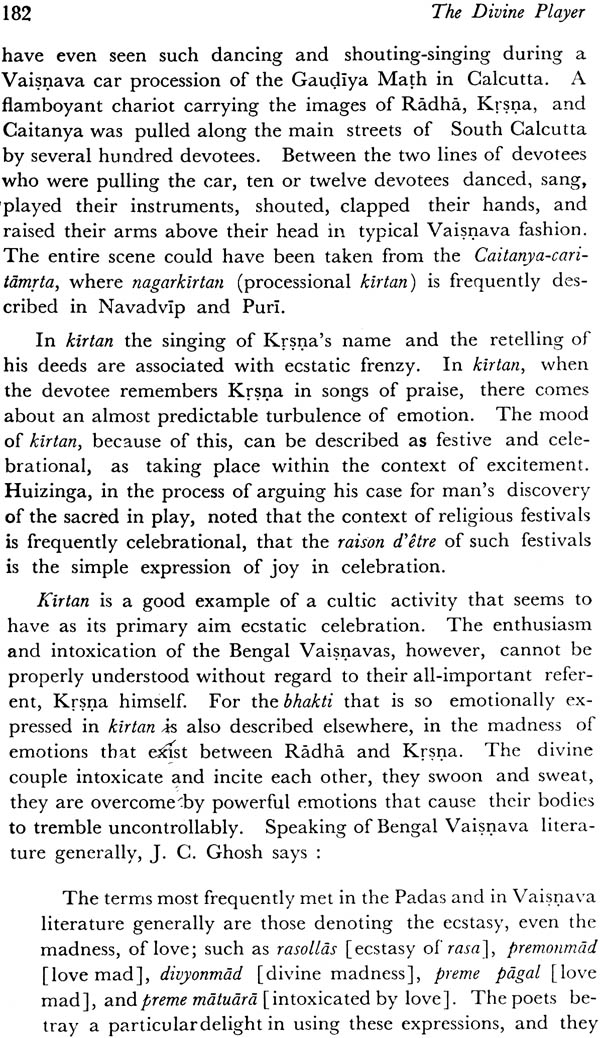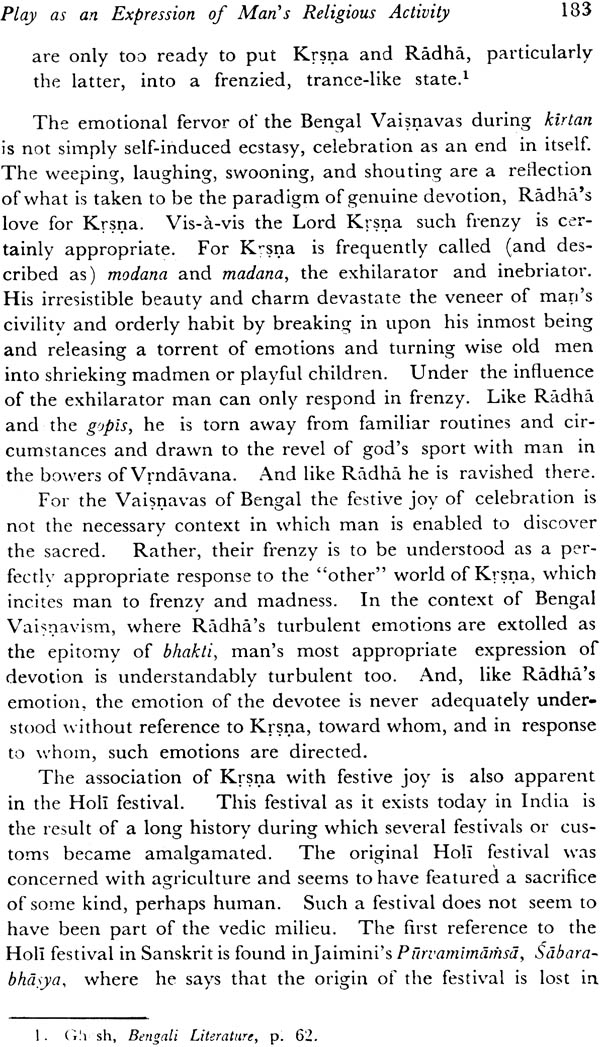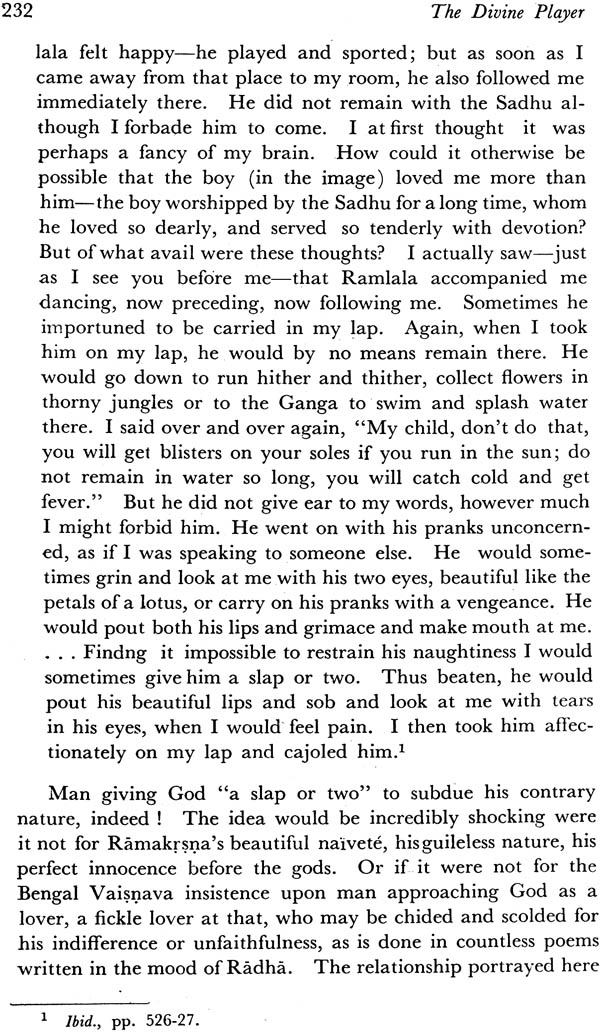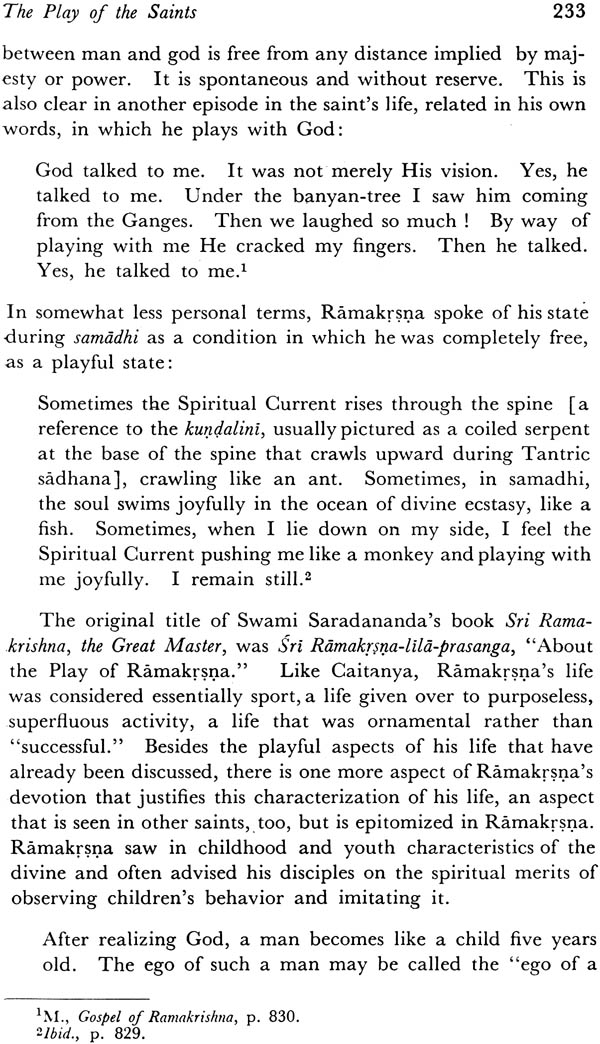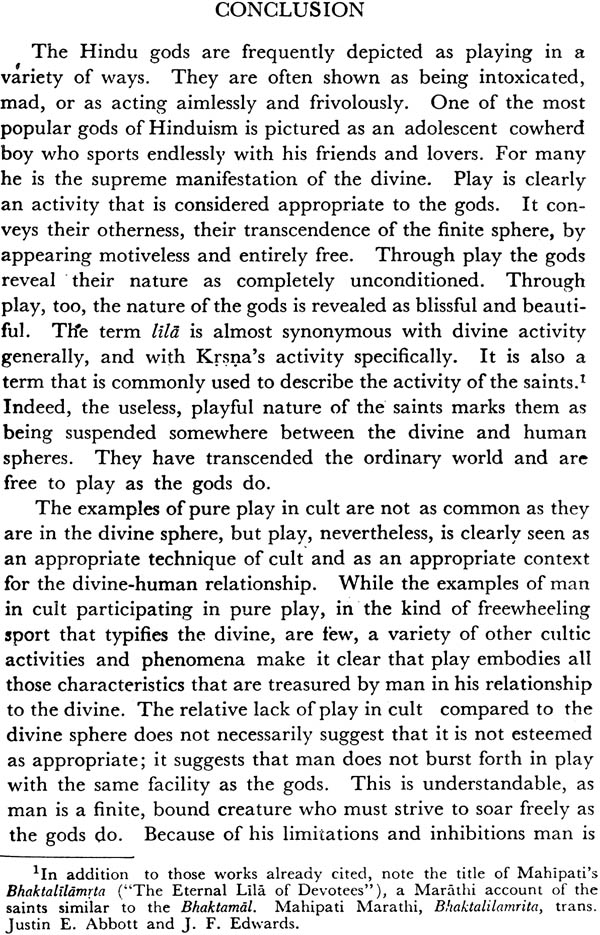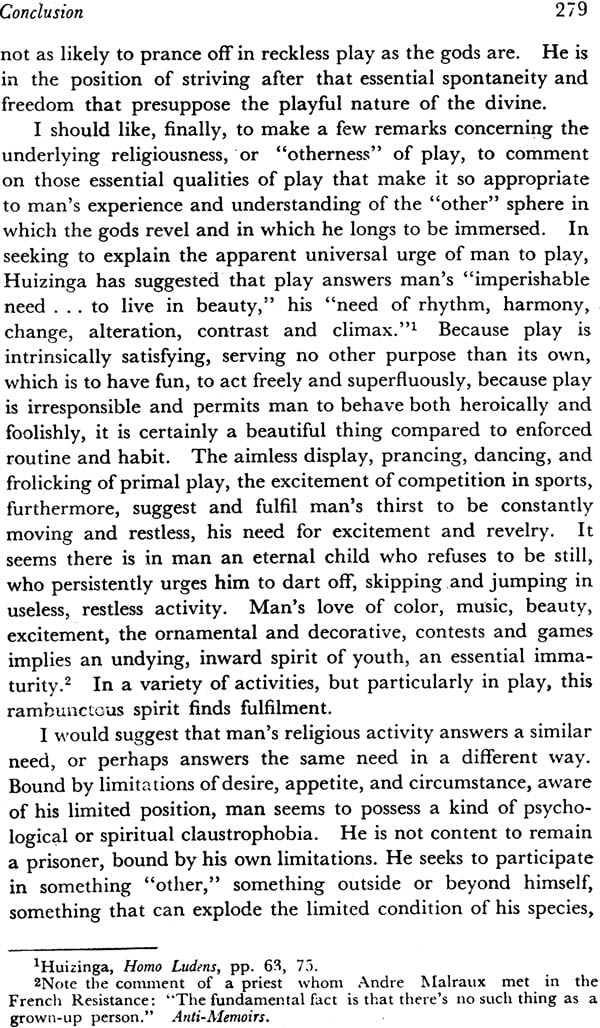
The Divine Player: A Study of Krsna Lila
Book Specification
| Item Code: | IDD305 |
| Author: | David R. Kinsley |
| Publisher: | MOTILAL BANARSIDASS PUBLISHERS PVT. LTD. |
| Language: | English |
| Edition: | 1996 |
| ISBN: | 9788120813137 |
| Pages: | 318 |
| Cover: | Hardcover |
| Other Details | 8.7" x 5.7" |
| Weight | 470 gm |
Book Description
About the Book
The Divine Player attempts to analyze the relationship between play and religion in the context of Hinduism. It focuses primarily on the youthful god Krsna. The first part of the book surveys the role of play among the gods and concludes that play seems to be an intrinsic part of the book investigates the role of play in religious cult, again focusing on the various Krsna cults. This section concludes that, although playful themes pervade man's religious activity in devotion to Krsna, cultic activity may not be reduced to play, as some scholars have suggested. The final section of the book points to examples of divine and cultic play in non-Hindu traditions.
Introduction
For the smile of the gods gave to the things of the cosmos their being and their power to continue.-Proclus in his commentary on the Timaeus
This dissertation is directed at understanding a problem that has interested me for some time: the relationship between play and religion. While this study does not pretend to be a definitive work on the subject, the problem is treated consistently throughout in the context of Indian religion.
It is my feeling that in previous studies the question of the relationship of play to religion has been posed in such a way as to neglect the central issue: the apparent significance of play itself as positive religious symbol and activity. Religion, for example, has been compared to play in that both involve make believe, or pretending. The conclusion drawn from such a comparison is often a negative one: that religion represents a childish stage in man's upward evolution to adulthood as a species. I think the comparison between the make believe world of play and the "other" world of religion is valid, but I think that the real significance of the similarity lies in the fact that in both play and religion man exercises and is captured by his world creating, imaginative faculty. And I am indeed reluctant to call this faculty a vestigial aspect of man's racial childhood.
The relationship between play and religion has also been studied from a developmental point of view. A rather vigorous debate, for example, has centered on the question of which phenomenon, play or religion, precedes or develops into the other. While it is clear that games play a part in certain rituals, and that certain games have become ritualized and while it is certainly interesting, not to say enlightening to know the history of how this comes about in particular situations, to pose the question in such developmental terms does little to inform us about what makes play an appropriate religious expression in and of itself.
The important fact to keep in mind, I think, is that in many traditions play is an appropriate religious expression. As a symbol of divine activity and as cultic activity, play clearly bears a positive relationship to religion generally. This is obviously clearer in some religions than in others, but its relative dispersement does not justify treating the problem in evolutionary or developmental terms. Play does not, for example, dominate so-called primitive religions, nor is it an uncommon feature of divine or cultic activity in the so-called high religions. The key to the relationship between the two phenomena, I think, is best understood by the fact that play participates in and expresses otherness. There is in or about play something that suggests the vital essence of religion itself.
There is religion, or in the religions, an irreducible element. There is what might be calle a vertical referent that is characteristic of religion generally. In the history of the history of religions this has been given various names in an attempt to define it more exactly. Otto called it the Holy; Van der Leeuw, Power; and Eliade, the Sacred, or the distinction between the sacred and the profane. Whatever we may call it, it is generally apprehended and expressed as something other. Indeed, "otherness" is perhaps the best term to describe this feature of religion.
An almost universal characteristic of otherness is its transcendence and unconditioned nature. The gods, for example, are supernatural. They are not limited by human frailty or hindrances. They express the unconditioned or transcendent nature of otherness in terms of knowledge (omniscience), spacelessness (the ability to change from at will, to be in more than one place at one time, or to be omnipresent), timelessness (the gods are frequently in the prime of youth, very old, or eternal), deathlessness (immortality), creativity, and power (omnipotence).
These characteristics are what might be called classic features of the divine. In almost every religious tradition the gods are gods because they are characterized by these features. In Hinduism the gods clearly possess all these classic features of divinity, yet it is also apparent that the Hindu gods are further characterized by their playful nature.
While play is perhaps not a classic feature of the divine in all religions, in Hinduism it is typical of the gods and represents, I think, an appropriate expression of the unconditioned and transcendent nature of the divine in India.
While the great variety of activities and phenomena that are called play makes it difficult to supply a simple, all-encompassing definition of the word, there are obvious characteristics of play that make it especially suitable to the divine sphere. Play, just as much as power, knowledge, and eternity, expresses the truth that the gods are not limited. For play expresses freedom; it is carefree and relatively unmotivated. Play is done for the fun of it, for no ulterior reason. As opposed to most other types of activity, it is intrinsically satisfying rather than instrumental. It is an end in itself. The gods act, but their acts cannot be understood simply within the structures of theological or ethical systems. In their complete otherness, their actions can only be called lila, which may be translated as "sport", "play", or "dalliance". To say that the gods act to satisfy any desire, to save man from injustice, even to free man from bondage, is to pretend to comprehend something that simply cannot be understood by man. The gods are entirely complete. They need and desire nothing. Their activity, therefore, is appropriately called lila. And lila is different from or "other" than, the world of here and now that is dominated by cause and effect, where man is forced to act out of necessity.
In the Hindu religious tradition the importance of play as divine activity indicates that play is a positive activity, an activity that partakes of the other realm of the gods. In the human sphere, therefore, it is not surprising that play is also understood as peculiarly religious activity in man's religious quest. Play itself, and many activities that share important characteristics with play, are central to Hindu cult, and particularly to the bhakti cults of North India. Play and playful activities such as dancing, singing, emotional frenzy, and madness signify that man has exploded the confines of his pragmatic, utilitarian nature and entered an "other" realm of freedom. They signify that he has transcended the ordinary and participates in the extraordinary.
In Hindu cult, particularly the bhakti cults, the mark of a great devotee of often the "uselessness" of his life. This is especially clear in the lives of the saints, who frequently behave like children, madmen, or drunkards and who are often depicted as being incapable of looking after themselves in the pragmatic world. As members of their society, they are quite unproductive. Their lives are mere ornaments. They are often incapable of sustained work or of acting in an orderly manner at all. They do not act according to the laws of cause and effect, so their actions appear motiveless to the laws of cause and effect, so their actions appear motiveless and aimless. Indeed, they are in many ways like the gods because they do not work but play.
This study will proceed, then, by first discussing the play of the gods. By illustrating its importance to and variety in the divine sphere it will be shown that play is considered a special activity in the Hindu tradition, an activity that is peculiarly appropriate to divinity. In this discussion I shall treat the god Krsna at length, as he is both one of the most popular Hindu gods and the most playful. I shall then proceed to discuss the place of play in Hindu cult in order to show the positive role of play, and activities that share important characteristics with play, in man's religious quest. I shall treat separately the lives of various Hindu saints, as they are both paradigmatic for man's devotional life and illustrative of the freed man. The saints have transcended the human condition and have entered the divine sphere, and an important indication of this fact is the spontaneous and superfluous nature of their lives. Finally, I shall discuss a few examples of play in non-Hindu religious traditions to show that play is also considered appropriate to the divine and cultic spheres outside India.
| Acknowledgements | v | |
| Introduction | ix | |
| ChapterI. | Play as Divine Activity in Hinduism | 1-55 |
| A. The play of creation and the world Dance | 1 | |
| B. Maya | 10 | |
| C. The Great Goddess and the play of Grace | 19 | |
| D. Divine Madness | 27 | |
| E. Divine Comedy | 31 | |
| F. The Heavenly Sporting Ground | 38 | |
| G. Combat as Play | 49 | |
| ChapterII. | Krsna's Lila | 56-121 |
| A. The Krsnas-Continuities and Discontinuities | 56 | |
| B. The Frolicking Child and Adolescent God | 60 | |
| C. Krsna's Sport with Demons | 70 | |
| D. The Most Relishable One | 74 | |
| E. The Divine Lover and his carnival of joy | 78 | |
| F. The call of Krsna's Flute | 95 | |
| G. Bhagavan-the Ocean of Bliss | 103 | |
| H. Vrndavana- Krsna's Playground | 112 | |
| I. "Without Krsna There is no Song" | 119 | |
| ChapterIII. | Play as an Expression of Man's Religious Activity | 122-203 |
| A. Play as an Expression of Cult | 122 | |
| B. Play as a Technique of Release-the "Other Mind" in Indian Art | 143 | |
| C. Becoming Krsna's Lover | 153 | |
| D. The Frenzy of Devotion: Firtan and Holi | 176 | |
| E. Bhakti, an Ovation of Bliss | 190 | |
| ChatpterIV | The Play of the Saints | 205-252 |
| A. The Love-Mad Caitanya | 205 | |
| B. Ramakrsna the Child | 220 | |
| C. Play in the Lives of Other Hindu Saints | 237 | |
| D. The place of Play in Medieval Hindu Cult: Summary | 248 | |
| ChapterV. | Play in Non-Hindu Traditions | 253-277 |
| A. Cosmic Time and the Insignificance of History in Hinduism | 253 | |
| B. Play outside the Hindu Tradition | 256 | |
| C. Play in the Judaic-Christian-"Post-christian" Tradition | 263 | |
| Conclusion | 278-281 | |
| Selected Bibliography | 283-298 | |
| Index | 299-306 |
